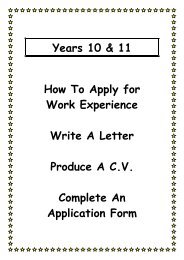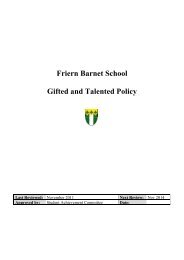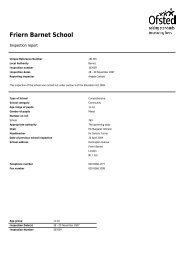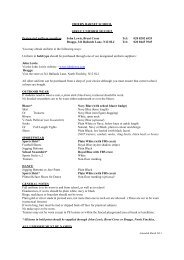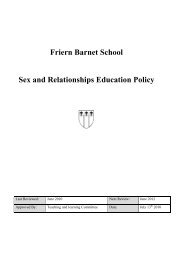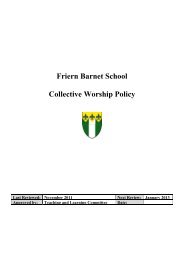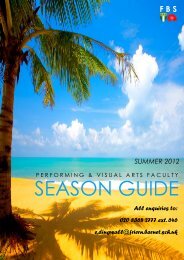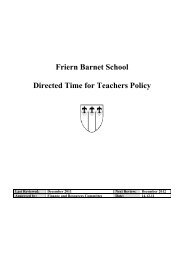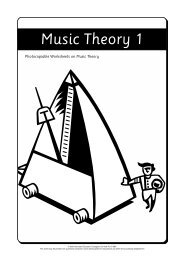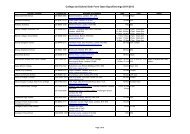VOL 166 Music Theory 2 - Friern Barnet School
VOL 166 Music Theory 2 - Friern Barnet School
VOL 166 Music Theory 2 - Friern Barnet School
You also want an ePaper? Increase the reach of your titles
YUMPU automatically turns print PDFs into web optimized ePapers that Google loves.
Name: ____________________ <strong>Music</strong> <strong>Theory</strong> 2 Worksheet<br />
WRITING FOR STRINGS (Part 1)<br />
As with any instrument the first consideration when writing for strings is to consider the pitch<br />
range of the instrument. It is also important to remember that in string writing a phrasing slur<br />
often shows the number of notes to be played in one bow rather than indicating the musical<br />
phrase shape.<br />
To indicate the direction of bowing use one<br />
of these two signs.<br />
downbow upbow<br />
When string players play a note without pressing their fingers on the fingerboard it is called an<br />
open string. Once the player presses down on the fingerboard this shortens the length of the<br />
string and it is said to be stopped.<br />
A different sound colour can be produced by playing a note on a different string. If you wanted<br />
to specify the string to be used this would be done by the phrase sul A, sul D etc.<br />
If two notes are played on the same string the<br />
performer would usually use two different<br />
fingers. If you wanted them to slide between<br />
the notes using the same finger you can draw<br />
a line between the two notes. This is called<br />
portamento.<br />
If you want the string player to pluck the string rather than bow it use the word pizzicato or<br />
pizz. To return to playing with the bow the word arco is used.<br />
If a player plays alternating bow strokes on single<br />
notes this is called a bowed tremolo. This is<br />
shown by three lines above or below the note<br />
for semibreves, three lines through the tail of<br />
the note if it is a minim or crotchet, two lines<br />
through the tail of the note for quavers and one<br />
line through the tail of the note for semiquavers.<br />
`6555555<br />
q q<br />
w h q etc.<br />
A double stop on a stringed instrument is when more than one note is palyed at the same time.<br />
Stringed instruments can only physically sustain two strings at once but you can play a three or<br />
four part chord by bowing quickly across the strings.<br />
www.keynoteseducation.com © 2004 Keynotes Education Crossgate Cornwall PL15 9SX<br />
This sheet may be printed from a personal computer and/or photocopied for educational use within the purchasing establishment<br />
29




